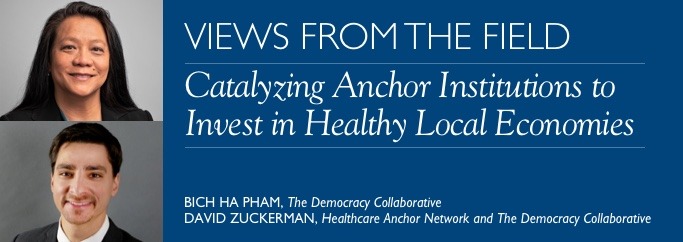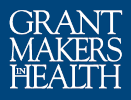
Bich Ha Pham, The Democracy Collaborative
Over the last two years, the Healthcare Anchor Network (HAN) has helped deepen our understanding of the role and potential of health systems, as anchor institutions in their communities, to address systemic economic and racial inequities. The collective activities and learning of this health system-led collaboration that is exploring what it means to embrace the “anchor mission” is supported by The Democracy Collaborative, a research, field-building, and advisory nonprofit focused on building community wealth and expanding economic democracy.
Health care is uniquely positioned to serve as an anchor sector because of its evolving mission toward more holistically addressing community and well-being, its stable role as one of the largest, community-rooted employers, and its mostly nonprofit and public status. An anchor mission entails an intentional commitment to use an institution’s place-based economic power, and human and political capital, to strengthen the local economic eco-system and address economic inequities.
A recent report that mapped the largest employer in every state underscored health care’s potential as anchors: it showed that a health system is the largest employer in at least 16 states, including HAN members University of Vermont Health Network in Vermont, Partners HealthCare in Massachusetts, Providence St. Joseph Health in Oregon and Alaska, and Intermountain in Utah (24/7 Wall St. 2019).
In addition to being large employers, health anchors are also among the largest purchasers and investors of capital in their communities. Nationally, health systems and universities have expenditures of more than $1 trillion annually, hold more than $500 million in investment assets, and employ more than 9 million people (Healthcare Anchor Network 2019). Their scale is enormous, and the potential to leverage their position to build stronger economies that prioritize equity, sustainability, and health and well-being is great.
More health systems are adopting the anchor mission as a strategic priority, and HAN has grown to include more than 45 health systems, totaling more than 700 hospitals. One member, UMass Memorial Health Care, illustrates this shift, reallocating resources, realigning institutional policy, and beginning to change the organization’s culture to help ensure the success of its anchor mission. Implemented over the latter half of 2018, the hospital’s three initial pilots focus in the areas of inclusive, local hiring; inclusive, local sourcing; and place-based impact investing (Ahmad Al Kasir 2019).
Place-based impact investing enables HAN members to collaborate across sectors to improve community health in areas such as affordable housing. For example, Kaiser Permanente’s Thriving Communities Fund has committed up to $200 million to address housing instability and homelessness in communities the health system serves (Kaiser Permanente 2017). The capital is being rapidly deployed: one example is a $50 million investment that is part of a joint equity fund with Enterprise Community Partners (Kaiser Permanente 2019). Along with Facebook, Genentech, the Silicon Valley Community Foundation, and other partners, the health system is also a member of the newly formed Partnership for the Bay’s Future that aspires to solve the interconnected structural and economic challenges facing the San Francisco Bay area (Partnership for the Bay’s Future 2019).
Other HAN members that have engaged in or committed to placed-based investing include Bon Secours Mercy Health, CommonSpirit Health, Intermountain Healthcare, Providence St. Joseph Health, Rush University Medical Center, Trinity Health, and UMass Memorial Health Care.
HAN members are also engaging in equitable economic development. In Cleveland, University Hospitals (UH) opened the UH Rainbow Center for Women and Children, which was designed, with the help of a community advisory board, to meet the needs of the community by co-locating health services, legal services, WIC, and a pharmacy (The Plain Dealer 2018). In Los Angeles, Kaiser Permanente collaborated with 2nd Call, a community organization that helps formerly incarcerated individuals successfully reenter society, to construct its new state-of-the-art Baldwin Hills-Crenshaw Medical Office Building (Kaiser Permanente 2017).
Anchor institutions recognize that while they can do a lot with their own resources, a truly systemic solution will involve improving policies and equitable resource allocation. Accordingly, HAN members engage in policy advocacy and use their political capital to address the social determinants of health. In this spirit, our inaugural Policy Day, held in February 2019, focused on federal policies that support safe, affordable, and healthy housing.
Funders have a pivotal role to play in encouraging adoption of the anchor mission in health care and other nonprofit and public sectors. It is vital that more community-rooted and civic institutions begin to center this approach as a strategic priority so that we can bring to bear the necessary economic and political capital to truly build more equitable and sustainable local economies.
With the support of health philanthropy, the health sector can increasingly focus upstream and leverage its resources to support local economies. As some have already done, health funders can encourage powerful new anchor collaborations and projects through their roles as trusted conveners and long-time partners. They can also be educators, communicating not only a new vision for health equity but also a sense of urgency.
Some health funders are driving investments or co-investing with anchor institutions. For example, the Health Foundation of South Florida’s Community Building and Economic Prosperity Initiative focuses on catalyzing additional investments in community wealth building strategies. Importantly, foundations can also invest their investment portfolios in anchor organizations’ strategies addressing the upstream determinants of health.
Funders have already played significant roles in promoting the anchor mission movement, and can potentially do more to help emerging new efforts overcome internal and external barriers, such as the fear of taking risks and aligning senior leadership and boards (Justine Porter 2019). Because funders are so well-respected and viewed as trusted, knowledgeable, connected, and strategic leaders, they can be game changers in this arena. They can put the anchor mission approach on the agenda, reach strategic champions in these institutions, connect key players with the experts to show them how to adopt and implement an anchor mission, and help provide seed funding to initiate the work.
It is clear that health institutions are among the largest employers in their states and regions. They are also some of the largest purchasers of goods and services and are in the uncommon position of having substantial investment funds that could be used for impact investing that aligns with their social mission. It is also true that business as usual will not address systemic inequities. With hundreds of thousands of community members experiencing avoidable negative health impacts, there is no time to waste to build communities where all can be healthy and thrive—and health funders can expand the map and change the playing field.
References
Brown, Monica, Susie Lee, Yanique Redwood and Elizabeth Ripley, “Hospital Anchor Mission and Community Health: Implications for Health Funders.” Grantmakers in Health, January 2018.
24/7 Wall St., “Walmart Nation: Mapping America’s Biggest Employers.” January 24, 2019.
Healthcare Anchor Network, “Healthcare Anchor Network.” 2019.
Al Kasir, Ahmad and Eric Coles, “Anchoring Health beyond Clinical Care: UMass Memorial Health Care’s Anchor Mission Project.” Harvard T.H. Chan School of Public Health. PH9-010, March 27, 2019.
Kaiser Permanente, “Announcing $200M impact investment to address housing crisis.” May 18, 2018.
Kaiser Permanente. “Kaiser Foundation Health Plan and Hospitals financial update.” May 10, 2019.
Partnership for the Bay’s Future, July 19, 2019.
Christ, Ginger, “University Hospitals Rainbow Center for Women & Children to open.” The Plain Dealer, July 9, 2018.
Health Foundation of South Florida. “Community Building.”
The California Endowment. “Investing in Place.” July 2, 2019.
Kaiser Permanente. “Improving Economic Security in our Communities.” September 23, 2017.
Porter, Justine and Danny Fisher-Brun, Bich Ha Pham. “Anchor Collaboratives: Building Bridges with Place-Based Partnerships and Anchor Institutions.” Washington, D.C. The Democracy Collaborative, May 8, 2019.

